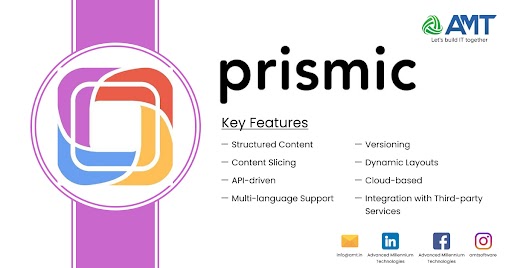Prismic is a content management system (CMS) that enables users to create, manage, and deliver digital content. It is designed to simplify the process of content creation and publication, providing a user-friendly interface for both technical and non-technical users.
Key features of Prismic include:
- Structured Content: Prismic allows users to define custom content types and structures, making it easy to organize and manage content in a structured manner.
- Content Slicing: Prismic uses a content slicing approach, where content is broken down into modular components called slices. This allows for greater flexibility in content creation and presentation.
- API-driven: Prismic is API-first, meaning that all content is accessible via an API (Application Programming Interface). This allows developers to integrate Prismic with various platforms, applications, and frameworks.
- Multi-language Support: Prismic supports the creation and management of content in multiple languages, making it suitable for websites and applications with a global audience.
- Versioning: Prismic includes versioning functionality, allowing users to track changes to content over time. This feature is beneficial for collaboration and content review processes.
- Dynamic Layouts: With Prismic, users can create dynamic layouts by combining different content types and slices, providing flexibility in designing the presentation of content.
- Cloud-based: Prismic is a cloud-based CMS, which means users can access and manage their content from anywhere with an internet connection.
- Integration with Third-party Services: Prismic supports integrations with various third-party services and tools, facilitating the incorporation of additional features and functionalities.
Developers often appreciate Prismic for its flexibility, ease of use, and the ability to deliver content via a headless CMS approach. In a headless CMS, the content management system is decoupled from the presentation layer, allowing developers to use their preferred front-end frameworks or technologies to build the user interface. Prismic’s API-first approach aligns well with this headless architecture.
Here are some additional aspects and details about Prismic:
- Customization: Prismic allows for extensive customization of content types and structures, enabling users to tailor the CMS to their specific needs. This flexibility is useful for a wide range of projects, from simple blogs to complex enterprise applications.
- Rich Media Handling: Prismic supports the management of various media types, including images, videos, and documents. It provides features for optimizing and delivering media assets efficiently.
- Preview Mode: Prismic offers a preview mode, allowing users to see how their content will look before publishing it. This can be crucial for content creators and editors to ensure that the content appears as intended.
- Search Functionality: Prismic includes search capabilities to help users find and manage content easily. The search functionality can be particularly important for websites or applications with large amounts of content.
- Content Relationships: Users can establish relationships between different pieces of content, facilitating the creation of complex and interconnected content structures.
- Webhooks: Prismic supports webhooks, enabling users to set up automated processes triggered by events in the CMS. This can be useful for various tasks, such as updating external systems or notifying stakeholders about content changes.
- Role-Based Permissions: Prismic provides role-based access control, allowing administrators to define user roles and permissions. This ensures that only authorized users can perform certain actions within the CMS.
- Developer-Friendly: Prismic is designed to be developer-friendly, with well-documented APIs and developer tools. This makes it easier for developers to integrate Prismic with other systems and build custom solutions.
- Content Modeling: Prismic emphasizes a content modeling approach, allowing users to define the structure of their content in a way that makes sense for their specific project. This is crucial for creating a consistent and organized content architecture.
- Community and Support: Prismic has an active community, including forums and documentation, providing a resource for users to seek help, share experiences, and access additional learning materials.
It’s important to note that the features and capabilities of Prismic may evolve over time, so checking the official documentation and community resources for the most up-to-date information is recommended.
Above is a brief about Prismic. Watch this space for more updates on the latest trends in Technology.
